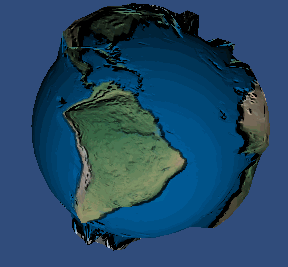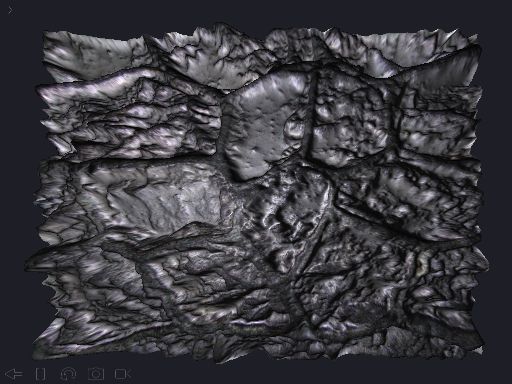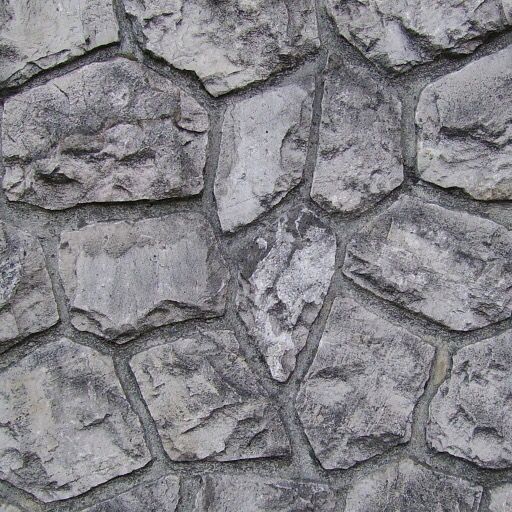2019独角兽企业重金招聘Python工程师标准>>> ![]()
在 OpenGL ES 2.0 上实现视差贴图(Parallax Mapping)
视差贴图
最近一直在研究如何在我的 iPad 2(只支持 OpenGL ES 2.0, 不支持 3.0) 上实现 视差贴图(Parallax Mapping) 和 位移贴图(Displacement Mapping).
经过一番研究, 搜索阅读了不少文章, 终于确定, OpenGL ES 2.0 可以支持 视差贴图, 暂时没什么好办法支持 位移贴图.
因为就我目前所了解的位移贴图, 有这么两种方法来实现, 一种是用 Tessellation 来提供多面数网格, 另一种是在顶点着色器中对高度图进行纹理采样来计算对应的顶点偏移量.
第一种方法就不必想了, 因为目前移动设备的 OpenGL ES 2.0/3.0 都不支持(貌似 DX11 和 OpenGL 4.0 才支持), 而 OpenGL ES 3.0 衍生自 OpenGL 3.3.
第二种方法目前看起来只能在 OpenGL ES 3.0 上使用, 请参考这篇文档Jim's GameDev Blog: 置换贴图 Displacement Mapping. 不过没办法在 OpenGL ES 2.0 上使用, 因为它要求在顶点着色器中进行纹理采样, 而这个特性恰恰是 2.0 不支持, 3.0 支持的.
我们可以看看 Jim 在 3.0 设备上实现位移贴图的效果:
原始图:
使用位移贴图后的效果:
好了, 现在在我们的 2.0 设备上实现我们的 视差贴图 吧, 先看看效果:
使用不同参数的效果:
- height_scale = -0.015
- height_scale = -0.055
![]()
- height_scale = -0.095
你可以灵活调整这些参数:
- lightPos: 光源位置
- viewPos: 眼睛位置
- height_scale: 高度图取样值缩放比例
看看这个视频 video:
代码如下:
function setup()
displayMode(OVERLAY)
print("试验 OpenGL ES 2.0 中位移贴图的例子")
print("Test the Parallax Mapping in OpenGL ES 2.0")
img1 = readImage("Dropbox:dm")
img2 = readImage("Dropbox:dnm1")
img3 = readImage("Dropbox:dm1")
local w,h = WIDTH,HEIGHT
local c = color(223, 218, 218, 255)
m3 = mesh()
m3i = m3:addRect(w/2,h/2,w/1,h/1)
m3:setColors(c)
m3.texture = img1
m3:setRectTex(m3i,0,0,1,1)
m3.shader = shader(shaders.vs,shaders.fs)
m3.shader.diffuseMap = img1
m3.shader.normalMap = img2
m3.shader.depthMap = img3
-- local tb = m3:buffer("tangent")
-- tb:resize(6)
tchx,tchy = 0,0
end
function draw()
background(40, 40, 50)
perspective()
-- camera(e.x, e.y, e.z, p.x, p.y, p.z)
-- 用于立方体
-- camera(300,300,600, 0,500,0, 0,0,1)
-- 用于平面位移贴图
camera(WIDTH/2,HEIGHT/2,1000, WIDTH/2,HEIGHT/2,-200, 0,1,0)
-- mySp:Sphere(100,100,100,0,0,0,10)
light = vec3(tchx, tchy, 100.75)
view = vec3(tchx, tchy, 300.75)
-- light = vec3(300, 300, 500)
-- rotate(ElapsedTime*5,0,1,0)
-- m3:setRect(m2i,tchx,tchy,WIDTH/100,HEIGHT/100)
setShaderParam(m3)
m3:draw()
end
function touched(touch)
if touch.state == BEGAN or touch.state == MOVING then
tchx=touch.x+10
tchy=touch.y+10
end
end
function setShaderParam(m)
m.shader.model = modelMatrix()
m.shader.lightPos = light
-- m.shader.lightPos = vec3(0.5, 1.0, 900.3)
m.shader.viewPos = vec3(WIDTH/2,HEIGHT/2,5000)
m.shader.viewPos = view
-- m.shader.viewPos = vec3(0.0, 0.0, 90.0)
m.shader.parallax = true
m.shader.height_scale = -0.015
end
-- 试验 视差贴图 中的例子
shaders = {
vs = [[
attribute vec4 position;
attribute vec3 normal;
attribute vec2 texCoord;
//attribute vec3 tangent;
//attribute vec3 bitangent;
varying vec3 vFragPos;
varying vec2 vTexCoords;
varying vec3 vTangentLightPos;
varying vec3 vTangentViewPos;
varying vec3 vTangentFragPos;
uniform mat4 projection;
uniform mat4 view;
uniform mat4 model;
uniform mat4 modelViewProjection;
uniform vec3 lightPos;
uniform vec3 viewPos;
void main()
{
//gl_Position = projection * view * model * position;
gl_Position = modelViewProjection * position;
vFragPos = vec3(model * position);
vTexCoords = texCoord;
// 根据法线 N 计算 T,B
vec3 tangent;
vec3 binormal;
// 使用顶点属性法线,并归一化
vec3 Normal = normalize(normal*2.0-1.0);
vec3 c1 = cross(Normal, vec3(0.0, 0.0, 1.0));
vec3 c2 = cross(Normal, vec3(0.0, 1.0, 0.0));
if ( length(c1) > length(c2) ) { tangent = c1; } else { tangent = c2;}
// 归一化切线和次法线
tangent = normalize(tangent);
binormal = normalize(cross(normal, tangent));
vec3 T = normalize(mat3(model) * tangent);
vec3 B = normalize(mat3(model) * binormal);
vec3 N = normalize(mat3(model) * normal);
mat3 TBN = mat3(T, B, N);
vTangentLightPos = lightPos*TBN;
vTangentViewPos = viewPos*TBN;
vTangentFragPos = vFragPos*TBN;
}
]],
fs = [[
precision highp float;
varying vec3 vFragPos;
varying vec2 vTexCoords;
varying vec3 vTangentLightPos;
varying vec3 vTangentViewPos;
varying vec3 vTangentFragPos;
uniform sampler2D diffuseMap;
uniform sampler2D normalMap;
uniform sampler2D depthMap;
uniform bool parallax;
uniform float height_scale;
vec2 ParallaxMapping(vec2 texCoords, vec3 viewDir);
vec2 ParallaxMapping1(vec2 texCoords, vec3 viewDir);
// The Parallax Mapping
vec2 ParallaxMapping1(vec2 texCoords, vec3 viewDir)
{
float height = texture2D(depthMap, texCoords).r;
return texCoords - viewDir.xy / viewDir.z * (height * height_scale);
}
// Parallax Occlusion Mapping
vec2 ParallaxMapping(vec2 texCoords, vec3 viewDir)
{
// number of depth layers
const float minLayers = 10.0;
const float maxLayers = 50.0;
float numLayers = mix(maxLayers, minLayers, abs(dot(vec3(0.0, 0.0, 1.0), viewDir)));
// calculate the size of each layer
float layerDepth = 1.0 / numLayers;
// depth of current layer
float currentLayerDepth = 0.0;
// the amount to shift the texture coordinates per layer (from vector P)
vec2 P = viewDir.xy / viewDir.z * height_scale;
vec2 deltaTexCoords = P / numLayers;
// get initial values
vec2 currentTexCoords = texCoords;
float currentDepthMapValue = texture2D(depthMap, currentTexCoords).r;
while(currentLayerDepth < currentDepthMapValue)
{
// shift texture coordinates along direction of P
currentTexCoords -= deltaTexCoords;
// get depthmap value at current texture coordinates
currentDepthMapValue = texture2D(depthMap, currentTexCoords).r;
// get depth of next layer
currentLayerDepth += layerDepth;
}
// -- parallax occlusion mapping interpolation from here on
// get texture coordinates before collision (reverse operations)
vec2 prevTexCoords = currentTexCoords + deltaTexCoords;
// get depth after and before collision for linear interpolation
float afterDepth = currentDepthMapValue - currentLayerDepth;
float beforeDepth = texture2D(depthMap, prevTexCoords).r - currentLayerDepth + layerDepth;
// interpolation of texture coordinates
float weight = afterDepth / (afterDepth - beforeDepth);
vec2 finalTexCoords = prevTexCoords * weight + currentTexCoords * (1.0 - weight);
return finalTexCoords;
}
void main()
{
// Offset texture coordinates with Parallax Mapping
vec3 viewDir = normalize(vTangentViewPos - vTangentFragPos);
vec2 texCoords = vTexCoords;
if(parallax)
texCoords = ParallaxMapping(vTexCoords, viewDir);
// discards a fragment when sampling outside default texture region (fixes border artifacts)
if(texCoords.x > 1.0 || texCoords.y > 1.0 || texCoords.x < 0.0 || texCoords.y < 0.0)
discard;
// Obtain normal from normal map
vec3 normal = texture2D(normalMap, texCoords).rgb;
normal = normalize(normal * 2.0 - 1.0);
// Get diffuse color
vec3 color = texture2D(diffuseMap, texCoords).rgb;
// Ambient
vec3 ambient = 0.1 * color;
// Diffuse
vec3 lightDir = normalize(vTangentLightPos - vTangentFragPos);
float diff = max(dot(lightDir, normal), 0.0);
vec3 diffuse = diff * color;
// Specular
vec3 reflectDir = reflect(-lightDir, normal);
vec3 halfwayDir = normalize(lightDir + viewDir);
float spec = pow(max(dot(normal, halfwayDir), 0.0), 32.0);
vec3 specular = vec3(0.2) * spec;
gl_FragColor = vec4(ambient + diffuse + specular, 1.0);
}
]]
}
其中法线图(img2),高度图(img3) 都是通过软件 CrazyBump 根据原始纹理(img1)生成的.
你也可以下载它们直接使用:
img1:
img2:
![]()
img3:
![]()
参考
38 视差贴图
视差贴图(Parallax Mapping)与陡峭视差贴图(Steep Palallax Mapping)
Parallax Occlusion Mapping in GLSL
Jim's GameDev Blog: 置换贴图 Displacement Mapping





